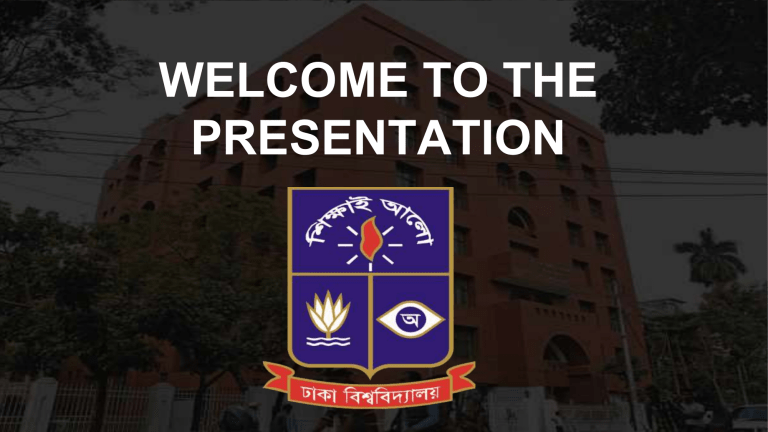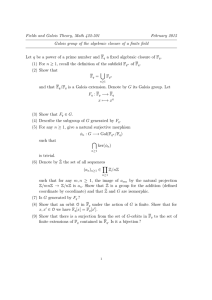
WELCOME TO THE
PRESENTATION
A SHORT STUDY OF GALOIS FIELD
Course Title: 4th Year Honors Project
Course Number: MTH 490
Presented By
Exam Roll Number: 2011
Reg. Number: H-1468
Admission Session: 2008-2009
OBJECTIVES:
To discuss the preliminaries of the project
Introduction of Galois Field
Examples of Galois Field
To discuss the related theorems of Galois Field
Computational approach of Galois Field
Applications of Galois Field
PRELIMINARIES
Set
Relation
Function
Binary operation
Group and related definitions
Ring and related definitions
Field and characteristic of field
SET:
A set is a well-defined collection of distinct objects. The
objects that make up a set (also known as the elements or
members of a set) can be anything: numbers, people, letters
of the alphabet and so on.
GROUP:
A non-empty set G is said to be a group in G there is defined
an operation “*” such that the following axioms are satisfied:
Closure property
Associative law
Existence of the identity element
Existence of the inverse of each element
GALOIS FIELD
Finite field
Definition of Galois field
example and theorem
Galois field is cyclic
Characteristic of Galois field
FINITE FIELD:
A field having only a finite number of elements is called a
finite field. Simply, a Galois field is a special case of finite
field.
GALOIS FIELD:
Galois Field :
A field in which the number of elements is of the form pn
where p is a prime and n is a positive integer, is called a
Galois field, such a field is denoted by GF (pn).
Example: GF (31) = {0, 1, 2} for ( mod 3) form a finite field of
order 3
DESCRIPTION OF THE EXAMPLE:
For GF-3.The elements are 0, 1 and 2. The multiplication
table is:
*
1
2
1
1
2
2
2
1
Table of reciprocals :
1
2
1
2
THE ADDITION TABLE IS:
+
0
1
2
0
0
1
2
1
1
2
0
2
2
0
1
The additive identity is 0
The additive inverse of 0 is 0
The additive inverse of 1 is 2
The additive inverse of 2 is 1
Here,GF-3 satisfied all the properties of Galois Field. So GF-3 is a Galois
Field of order 3.
THEOREMS OF GALOIS FIELD:
The multiplicative group of GF ( pn ) is cyclic, Where p is a
prime number and n is an integer.
GF(pn)has a subfield 𝐹 ′ with pm elements if and only if m|n .
Moreover,𝐹 ′ is unique.
Let F be a finite field. Then the number of elements of F is pn for
some positive integer n.
THEOREMS OF GALOIS FIELD:
Let F be a finite field with pn elements and let α ∈ F. Then there exist
elements μ and ν in F such that α= μ 2+ ν2
Each element of a finite field with elements satisfies the equation
𝑛
𝑝
𝑥 = x.
COMPUTATIONAL APPROACH OF GALOIS
FIELD
Verification of sum of two squares theorem of last chapter
Some examples of Galois field
Finite field arithmetic (Addition & subtraction)
Primitive Polynomial
Application
VERIFICATION:
Here I have verified the theorem α = μ 2+ ν2 , where α, μ, ν ∈ F and F is a Field of pn elements. I
verified this theorem by FORTRAN programming language.
I verified the theorem for p =11, n = 1, i.e. for Galois field GF (11).
𝑍11 = {0, 1,2,3,4,5,……..9,10 } is a field. Thus we may consider GF(11) = 𝑍11 . We can easily check
that every element of 𝑍11 satisfy the polynomial 𝑥 11 -x 𝑍11 by using FORTRAN programming
language, where every αGF(11) and µ, ν GF(11).
SOLUTION BY FORTRAN:
DIMENSION MAT (100)
INTRGER MAT, K1, CAL, REM
WRITE (*,*)’ENTER A PRIME NUMBER:’
READ (*,*) K1
DO 4 I=K1, 1
MAT (I) =I-1
4 CONTINUE
WRITE (*,*)’REQUIRED ROOTS ARE IN 𝑍𝑃 :’
WRITE (*,*) (MAT (I), I=1, K1, 1)
WRITE (*,*)’
WRITE (*,*)’EVERY ROOT CAN BE EXPRESSED AS:’
DO 1 I=1, K1, 1
DO 2 J=I, K1, 1
DO 3 K=J, K1, 1
CAL= (MAT (J) **2) + (MAT (K) **2)
REM=MOD (CAL, K1)
IF (MAT (I).EQ.REM) THEN
WRITE (6, 5) MAT (I), MAT (J), MAT (K)
5 FORMAT(1X,I2,’=’,I2,’^2+’,I2,’^2’)
GO TO 1
END IF
3 CONTINUE
2 CONTINUE
1 CONTINUE
STOP
END
OUTPUT OF THE PROGRAM:
Input: The Prime Number 11
Output: Required Roots are in 𝑍𝑃 is
0
1
2
3
4
5
6
Every Root Can be expressed as:
0
=
02 + 02
1
3
=
02 + 42
4
6
=
32 + 62
7
9
=
02 + 32
10
=
=
=
=
02 + 12
02 + 22
22 + 42
12 + 32
7
8
9
10
2
5
8
=
=
=
12 + 1 2
12 + 2 2
22 + 2 2
Since it is possible to write α=µ2 +𝜐 2 where α, µ,𝜐 𝑍11 then we conclude that every root can be
expressed as the sum of two squares.
REFERENCES:
Hiram Palely and Paul M. Weichsel: “A First Course in Abstract Algebra” New York, Holt, 1996.
R. S. Aggarwal: A text book on modern algebra
Mary Gray: “A radical approach to algebra”, Addison-Wesley publishing Co. London, 1970.
Professor Abdur Rahman : “ Abstract Algebra ”,Dhaka,1995.
Bhattacharya, P.B. adds Jain, S.K., and Naipaul: “A first course in rings, fields and vector spaces,
Halsted Press, New York, 1977.
www.mathworld.wolfarm.com
https://www.wikipedia.org/
http://www.wikihow.com/Main-Page
http://stackoverflow.com/
www.andrew.edu
www.encyclopedia.com
THANK YOU


